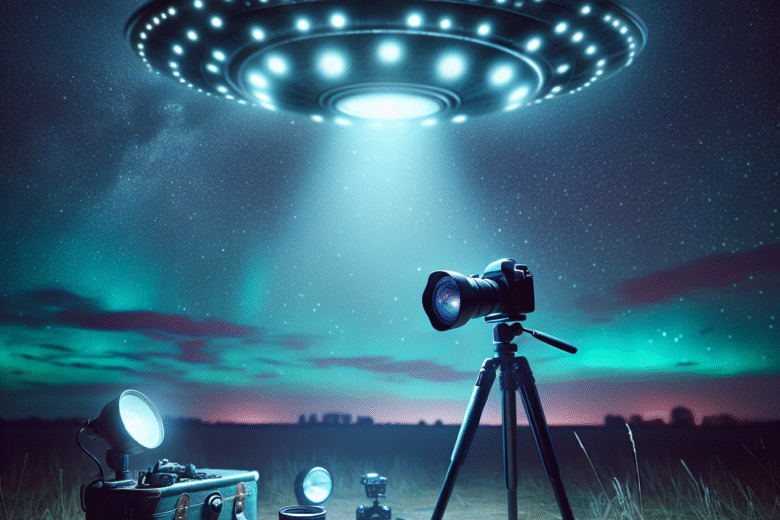UFO Photography Equipment: Capturing the Perfect Shot
In recent years, the fascination with UFOs has surged, drawing amateur and professional photographers alike to capture these enigmatic phenomena. Whether you’re a believer or just a curious photographer, having the right equipment is crucial to capturing that elusive perfect shot. In this guide, we’ll explore the essentials of UFO photography equipment, offering tips and tricks to ensure you’re always ready for that unexpected moment. 📷👽
Table of Contents:
1. The Essentials of UFO Photography Equipment
2. Choosing the Right Camera
3. Lens Selection for UFO Photography
4. Stabilization Tools: Tripods and More
5. Lighting and Night Photography
6. Post-Processing Tips
7. FAQs
The Essentials of UFO Photography Equipment
Before diving into the specifics, let’s cover the basic gear you’ll need. Quality photography gear ensures you’re prepared for any sighting, day or night. Here’s a quick rundown of what’s essential:
1. A reliable camera capable of shooting in various lighting conditions.
2. Lenses with diverse focal lengths to capture both wide shots and close-ups.
3. A sturdy tripod for stabilization during long exposures.
4. Extra batteries and memory cards, because UFOs wait for no one.
5. A good photo-editing software to enhance your captures.
Choosing the Right Camera
The heart of your UFO photography toolkit is your camera. While smartphone cameras have advanced significantly, a DSLR or mirrorless camera still holds the edge in terms of versatility and quality. Look for cameras with excellent low-light performance and fast autofocus capabilities. The ability to shoot in RAW format is also beneficial, as it allows for greater flexibility in post-processing.
Consider models like the Canon EOS R6 or the Sony A7 III, both of which offer superb low-light sensitivity and fast continuous shooting modes, perfect for capturing fast-moving objects in the sky.
Lens Selection for UFO Photography
Lenses are equally important as the camera itself. For UFO photography, having a range of lenses ensures you’re ready for both wide atmospheric shots and detailed close-ups. A wide-angle lens (such as a 16-35mm) can capture expansive sky views, while a telephoto lens (like a 70-200mm) is ideal for zooming in on distant objects.
Investing in lenses with fast apertures (f/2.8 or lower) is advisable, as they perform better in low-light conditions, which is crucial for night-time UFO sightings.
Stabilization Tools: Tripods and More
Stabilization is key when photographing UFOs, especially at night. A sturdy tripod is non-negotiable, as it allows for long exposure shots without the blur caused by camera shake. Look for tripods that are lightweight yet robust, making them easy to transport during your skywatching adventures.
For added stability, consider using a remote shutter release. This tool helps minimize vibrations when taking the shot, ensuring sharper images.
Lighting and Night Photography
Most UFO sightings occur at night, making understanding low-light photography essential. A camera with high ISO capabilities is beneficial, but be wary of noise. Experiment with different exposure times and apertures to find the right balance for clear, crisp images.
Consider using a red flashlight to maintain night vision while adjusting your camera settings. This small tip can make a big difference when trying to keep an eye on the sky.
Post-Processing Tips
Once you’ve captured your UFO shots, post-processing can help highlight details that might not be immediately visible. Software like Adobe Lightroom or Photoshop offers tools to enhance contrast, adjust exposure, and reduce noise, all of which can improve your final images.
Remember to maintain the authenticity of your captures. Over-editing can detract from the credibility of your photos, especially if you plan on sharing them with the UFO enthusiast community.
FAQs
Q: Can I capture UFOs with a smartphone?
A: While it’s possible, a DSLR or mirrorless camera offers better quality and flexibility, especially in low-light conditions.
Q: What settings should I use for night photography?
A: Start with a high ISO (1600+), a wide aperture (f/2.8 or lower), and a slow shutter speed. Adjust based on the ambient light conditions.
Q: How important is post-processing?
A: It’s quite important for enhancing details, but it’s essential to keep edits subtle to maintain photo authenticity.
Conclusion
Capturing the perfect UFO shot requires a combination of the right equipment, knowledge, and a bit of luck. By investing in quality gear and honing your photography skills, you’ll be well-prepared for your next encounter with the unknown. Remember, the sky is full of mysteries waiting to be captured—stay curious and keep your camera ready! 🌌✨
Looking for a side hustle
Check out one of the best around atm
